Aiserman M., Gusev L., Rozonoer L., Smirnova l., Tal A. Logic, Automata, and Algorithms
Подождите немного. Документ загружается.

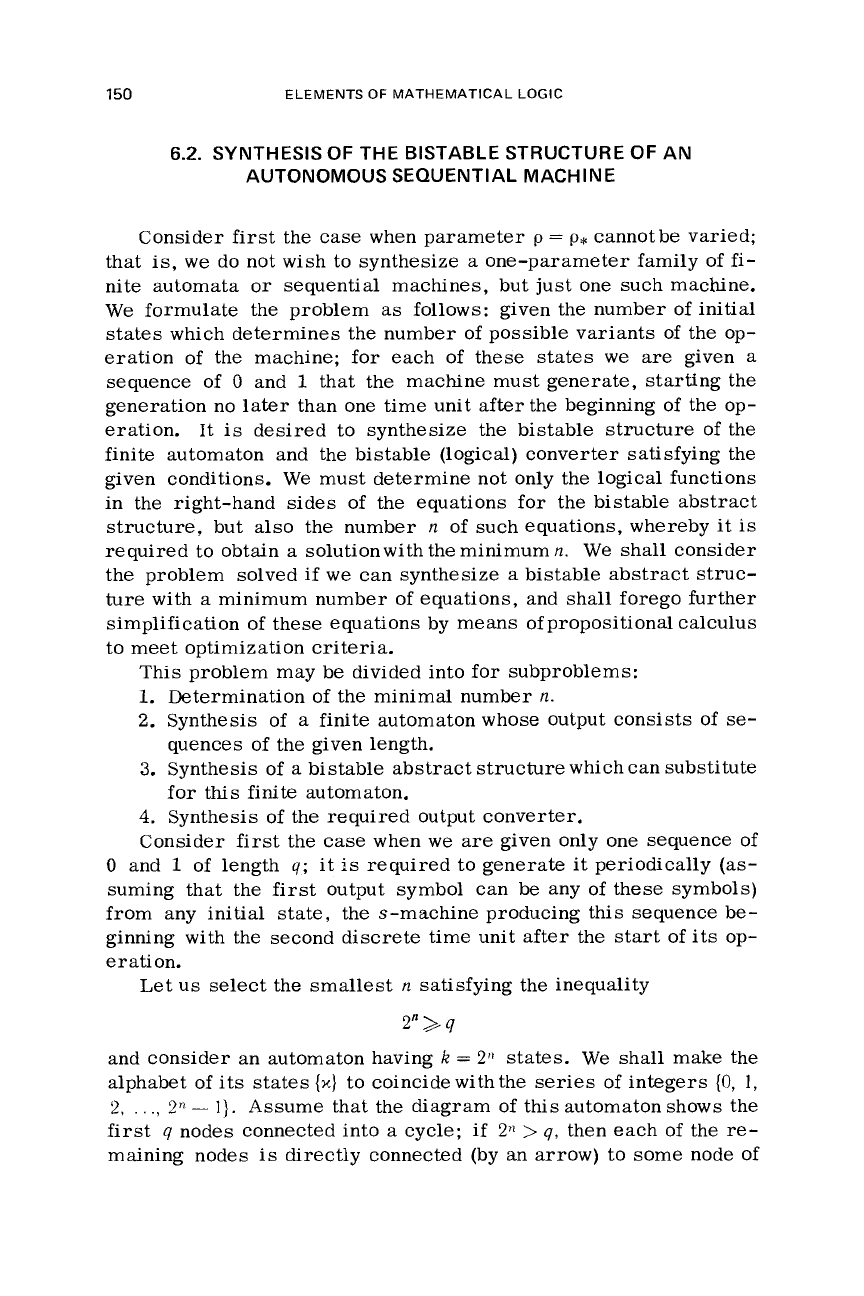
150
ELEMENTS
OF
MATHEMATICAL
LOGIC
6.2. SYNTHESIS
OF
THE BISTABLE STRUCTURE
OF
AN
AUTONOMOUS SEQUENTIAL MACHINE
Consider
first
the
case when parameter
p
=
p*
cannotbe varied;
that
is,
we
do not wish to synthesize
a
one-parameter family of
fi-
nite automata
or
sequential machines, but just one such machine.
We formulate
the
problem
as
follows: given the number of initial
states which determines the number of possible variants of
the
op-
eration of the machine; for
each
of these states
we
are
given
a
sequence of
0
and
1
that
the
machine must generate, starting the
generation no
later
than one time unit
after
the beginning of the op-
eration.
It
is
desired to synthesize the bistable structure of the
finite automaton and the bistable (logical) converter satisfying the
given conditions.
We
must determine not only the logical functions
in the right-hand
sides
of the equations for the bistable abstract
structure, but also
the
number
n
of such equations, whereby
it
is
required to obtain
a
solution with the minimum
n. We
shall consider
the problem solved
if
we
can synthesize
a
bistable abstract struc-
ture
with a minimum number of equations, and shall forego further
simplification of these equations
by
means
of
propositional calculus
to meet optimization criteria.
This
problem may be divided into for subproblems:
1.
Determination of the minimal number
n.
2.
Synthesis of a finite automaton whose output consists
of
se-
quences of the given length.
3.
Synthesis of
a
bistable abstract structure which can substitute
for
this
finite
automaton.
4.
Synthesis of
the
required output converter.
Consider first the case when
we
are
given only one sequence of
0
and
1
of length
q;
it
is
required to generate
it
periodically
(as-
suming that
the
first output symbol can be any of these symbols)
from any initial state,
the
s-machine producing
this
sequence be-
ginning with the second discrete time unit after the start of its op-
e
ration.
Let us select the smallest
n
satisfying the inequality
2”>q
and consider an automaton having
k
=
2?1
states.
We
shall make the
alphabet of its states
{x)
to coincide withthe
series
of integers
{O,
1,
2,
.
,
.,
2“
-
I).
Assume that the diagram of this automaton shows the
first
q
nodes connected into
a
cycle;
if
2’1
>
q,
then each of the
re-
maining nodes
is
directly connected (by
an
arrow) to some node of
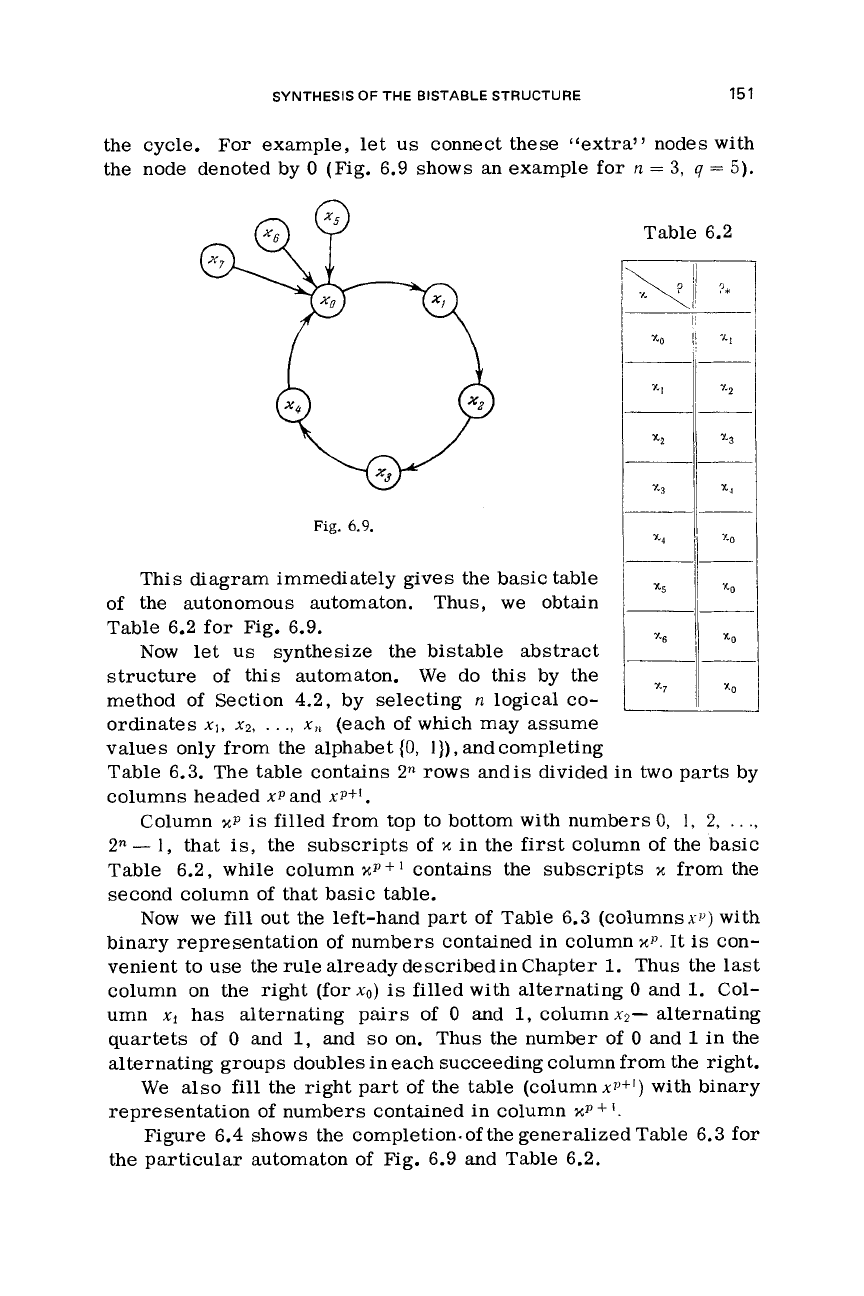
SYNTHESIS
OF
THE
BISTABLE
STRUCTURE
151
the
cycle. For example,
let
us connect these nodes with
the node denoted by
0
(Fig. 6.9 shows an example for
n
=
3,
q
=
5).
Table 6.2
Fig.
6.9.
This diagram immediately gives the basic table
of
the autonomous automaton, Thus,
we
obtain
Table 6.2 for Fig. 6.9.
Now let us synthesize the bistable abstract
structure of this automaton.
We
do this by the
method of Section
4.2,
by selecting
n
logical co-
ordinates
xi,
x2,
.
.
.,
x,, (each
of
which may assume
values only from the alphabet
(0,
I}),
and completing
Table 6.3. The table contains
2n
rows andis divided in
two
parts by
columns headed
xp
and
xp+l.
Column
xp
is
filled from top to bottom with numbers
0,
1,
2,
. .
.,
2"
-
1,
that
is,
the subscripts of
x
in the first column of the basic
Table 6.2, while column
xp+I
contains the subscripts
x
from the
second column of that basic table.
Now
we
fill
out the left-hand part of Table 6.3 (columns,xIj) with
binary representation of numbers contained in column
xp.
It
is
con-
venient to use the rule alreadydescribedin Chapter
1.
Thus the
last
column on the right (for
xg)
is
filled with alternating
0
and
1.
Col-
umn
xi
has alternating pairs of
0
and
1,
columnx2- alternating
quartets of
0
and
1,
and
so
on. Thus the number
of
0
and
1
in the
alternating groups doubles in each succeeding column from the right.
We
also
fill
the right part of the table (columnx7J+I) with binary
representation of numbers contained in column
?tp+
I.
Figure 6.4 shows the completion.of the generalized Table 6.3 for
the particular automaton of
Fig.
6.9 and Table 6.2.
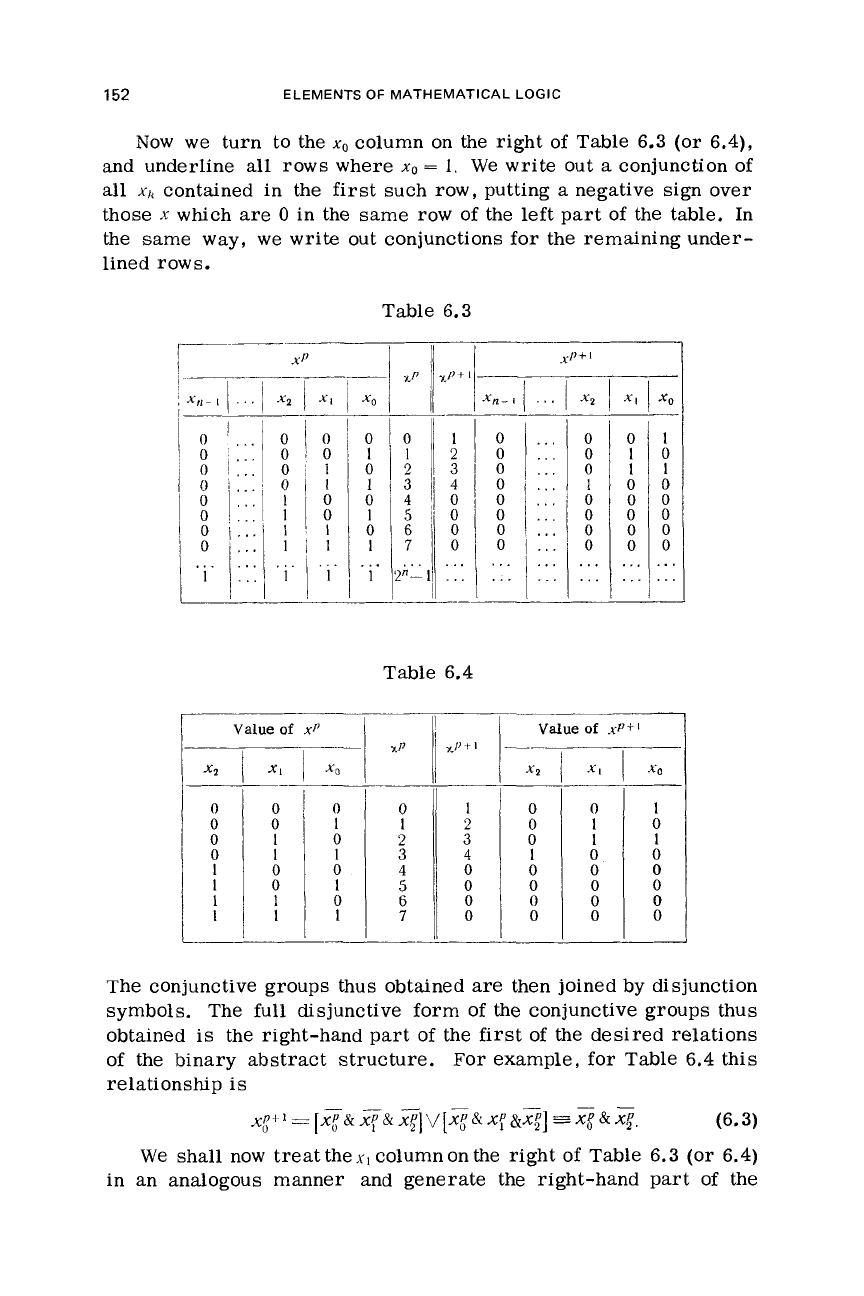
152
ELEMENTS
OF
MATHEMATICAL LOGIC
Now
we
turn to the
x,,
column on the right of Table 6.3 (or 6.4),
and underline
all
rows where
xo
=
1.
We
write out
a
conjunction of
all
xk
contained in the first such row, putting
a
negative sign over
those
x
which
are
0
in the same row of the left part of the table.
In
the same
way,
we
write
out conjunctions for the remaining under-
lined rows.
Table 6.3
Table 6.4
I
Value
of
x"
Value
of
xp
+
I
0
0
1
0
0
I
0
1
2
0
1
0
1
0
2
3
0
1
1
1
3
4
I
0
0
0
4
0
0
0
0
1
5
0
0
0 0
1
0
6
0
0
0 0
1
1
7
0
0
0
0
The conjunctive groups thus obtained
are
then joined by disjunction
symbols. The full disjunctive form of the conjunctive groups thus
obtained
is
the right-hand part of the first of the desired relations
of the binary abstract structure. For example,
for
Table 6.4 this
relationship
is
-
--
.~"=[.,pa~a~]v[.,peixp&x~]
=Xg&X;.
(6.3)
We shall now treatthex, columnonthe right
of
Table 6.3
(or
6.4)
in an analogous manner and generate the right-hand part of the
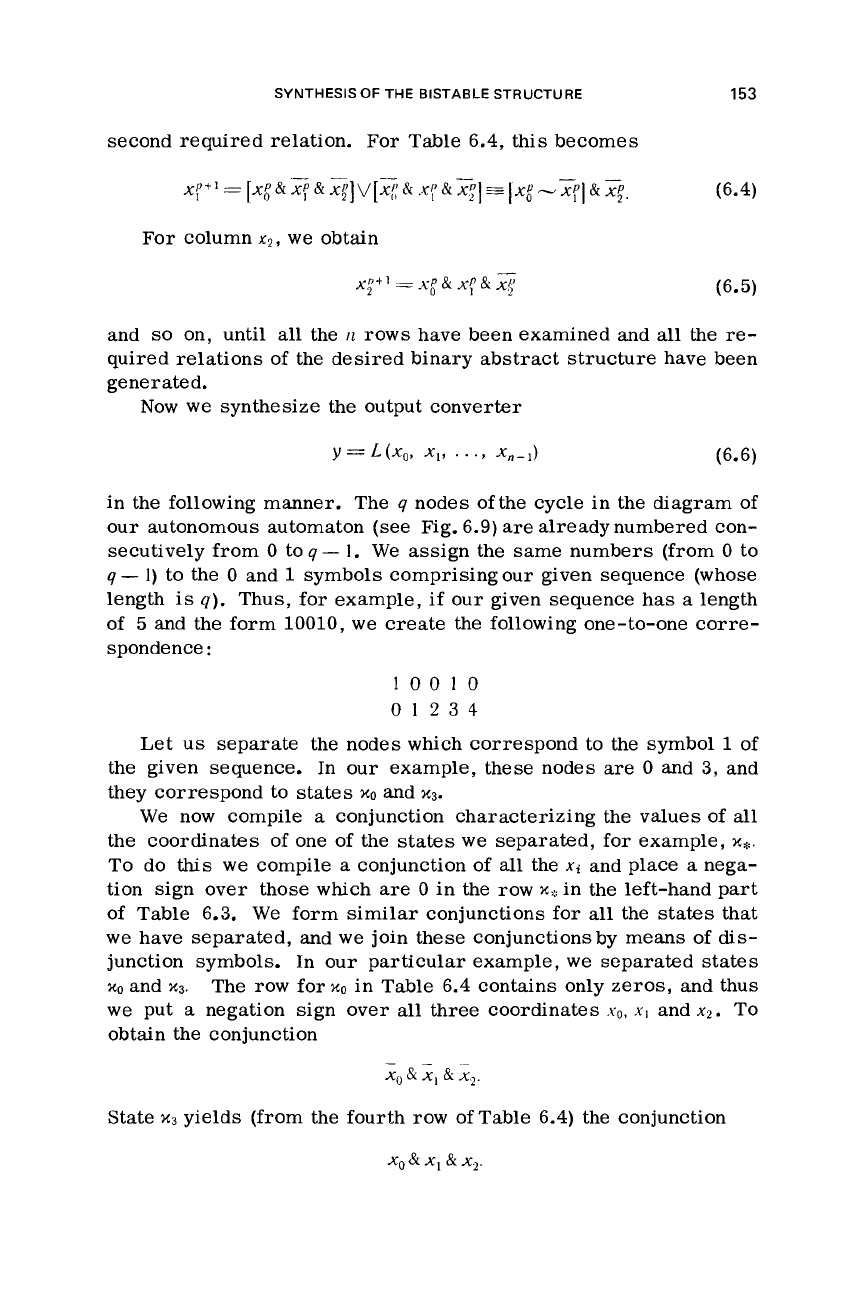
SYNTHESIS
OF
THE BISTABLE STRUCTURE
153
second required relation. For Table 6.4,
this
becomes
(6.4)
For column
xp,
we
obtain
and
so
on, until
all
the
rz
rows have been examined and
all
the
re-
quired relations of
the
desired binary abstract structure have been
generated.
Now we synthesize the output converter
in the following manner. The
q
nodes ofthe cycle in the diagram of
our autonomous automaton
(see
Fig. 6.9)
are
already numbered con-
secutively from
0
to
q
-
1.
We
assign
the
same numbers (from
0
to
q-
1)
to
the
0
and
1
symbols comprisingour given sequence (whose
length
is
9).
Thus, for example,
if
our given sequence has
a
length
of
5
and the form
10010,
we
create
the following one-to-one corre-
spondence
:
10010
01234
Let us separate the nodes which correspond to the symbol
1
of
the given sequence. In our example, these nodes
are
0
and
3,
and
they correspond to states
xo
and
x3.
We
now compile
a
conjunction characterizing the values of
all
the coordinates of one of the states
we
separated, for example,
x*.
To do
this
we compile
a
conjunction of
all
the
xi
and place
a
nega-
tion sign over those which
are
0
in the row
x-
in the left-hand part
of Table 6.3.
We
form similar conjunctions for
all
the states that
we have separated, and
we
join these conjunctions by means of
dis-
junction symbols. In our particular example,
we
separated states
xo
and
x3.
The row for
xo
in Table 6.4 contains only zeros, and thus
we put
a
negation sign over
all
three coordinates
so,
xi
and
x2.
To
obtain the conjunction
State
x3
yields (from the fourth row of Table 6.4) the conjunction
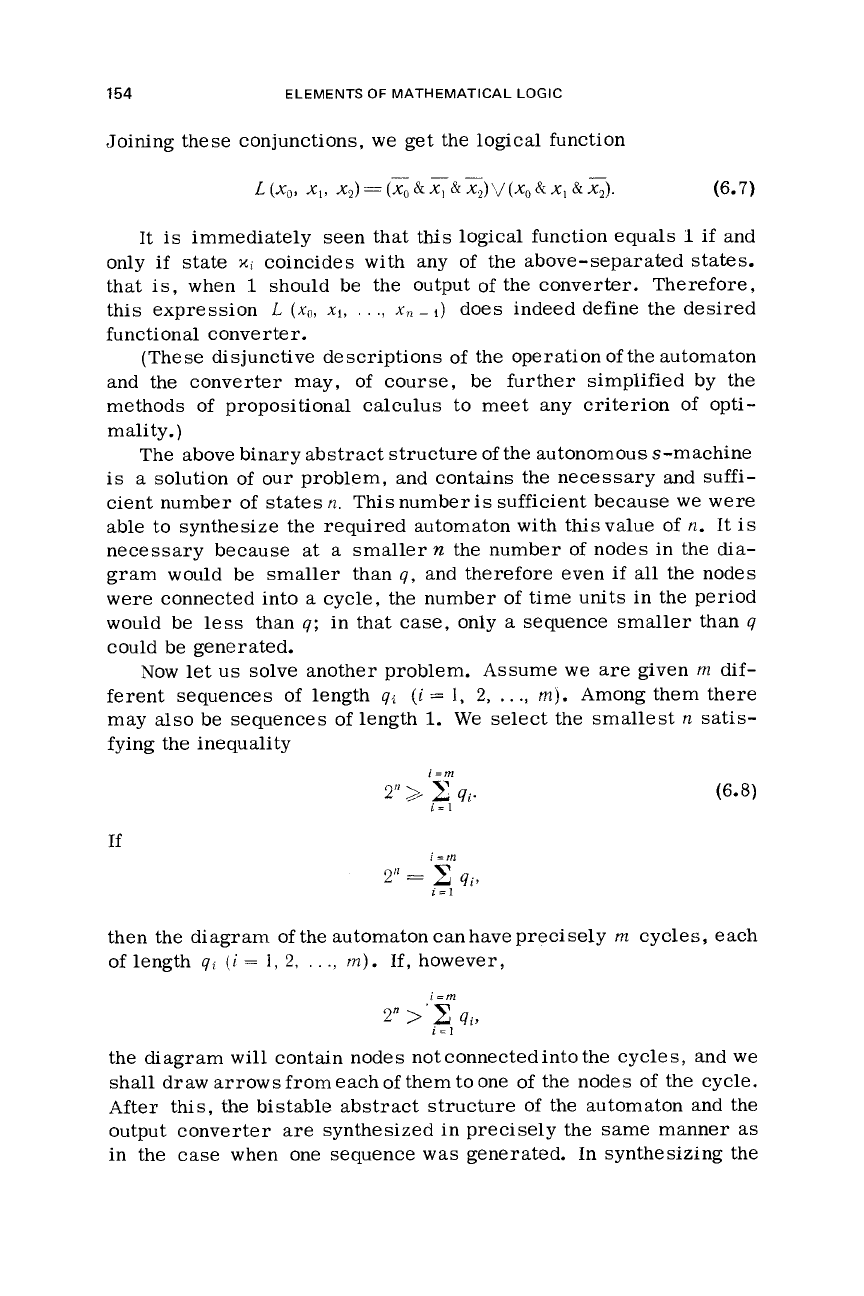
154
ELEMENTS OF MATHEMATICAL LOGIC
Joining
these
conjunctions,
we
get
the
logical function
(6.7)
It
is
immediately seen that
this
logical function equals
1
if
and
only
if
state
x,
coincides with any of the above-separated states.
that
is,
when
1
should be the output of
the
converter. Therefore,
this expression
L
(xo,
xI,
. .
.,
xn
-
i)
does indeed define the
desired
functional converter.
(These disjunctive descriptions of the operation of the automaton
and the converter may, of course, be further simplified by
the
methods of propositional calculus to meet any criterion of opti-
mali ty
.
)
The above binary abstract structure of
the
autonomous s-machine
is
a solution of
our
problem, and contains the necessary
and
suffi-
cient number of states
n.
This number
is
sufficient because
we
were
able to synthesize the required automaton with thisvalue
of
n.
It
is
necessary because at
a
smaller
n
the number of nodes in the
dia-
gram would be smaller than
q,
and therefore even
if
all
the
nodes
were
connected into
a
cycle, the number of time units in the period
would be less than
q;
in that case, only
a
sequence smaller than
q
could be generated.
Now let
us
solve another problem. Assume
we
are
given
m
dif-
ferent sequences
of
length
qi
(i
=
1,
2,
.
.
.,
m).
Among them there
may
also
be sequences of length
1.
We
select the smallest
n
satis-
fying
the
inequality
i=m
2"
>
2
qi.
i-1
If
then the diagram of
the
automaton canhave precisely
rn
cycles,
each
of length
qi
(i
=
I,
2,
. .
.,
m).
If, however,
the diagram
will
contain nodes not connectedinto the cycles, and
we
shall
draw
arrows from each of them to one of the nodes of the cycle.
After
this,
the
bistable abstract structure
of
the automaton and the
output converter are synthesized in precisely the same manner
as
in the case when one sequence was generated. In synthesizing the
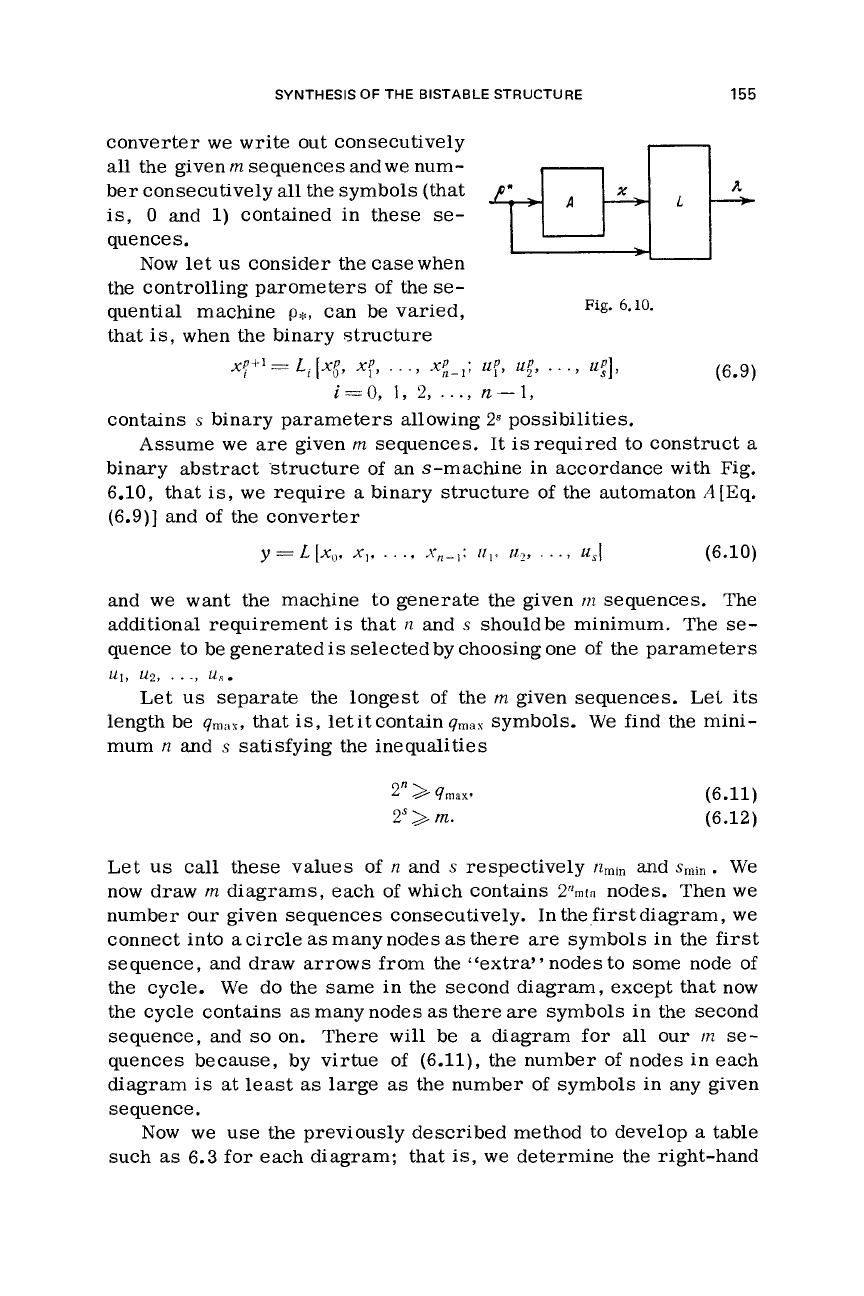
SYNTHESIS
OF
THE
BISTABLE
STRUCTURE
155
converter
we
write out consecutively
all
the given
m
sequences and
we
num-
ber consecutively
all
the symbols (that
is,
0
and
1)
contained in these
se-
quences.
Now
let
us consider the
case
when
the controlling parometers
of
the
se-
quential machine
pI,
can be varied,
that is, when the binary structure
Fig.
6.10.
(6.9)
xf’-’=
L,
pg,
xp,
. .
.)
xi-,;
up,
ug,
.
.
.,
u;],
i=o,
1,
2,
...
)
n-1,
contains
s
binary parameters allowing
2s
possibilities.
Assume
we
are
given
m
sequences. It
is
required to construct
a
binary abstract ‘structure of an s-machine in accordance
with
Fig.
6.10, that
is,
we
require
a
binary structure
of
the automaton A[Eq.
(6.9)]
and of the converter
y
=
L
[x,,.
x,,
.
.
.
,
/I,.
N2,
. . .
,
us\
(6.10)
and we want the machine
to generate the given
m
sequences. The
additional requirement
is
that
IZ
and
s
shouldbe minimum. The
se-
quence to be generated
is
selected by choosing one
of
the parameters
ui,
u2,
. .
.,
u,s.
Let us separate the longest
of
the
m
given sequences. Let
its
length be
qm;,\-,
that is,
let
it contain
qmas
symbols.
We
find the mini-
mum
n
and
s
satisfying the inequalities
(6.11)
(6.12)
Let us
call
these values of
n
and
s
respectively
rimin
and
smin.
We
now draw
m
diagrams, each of which contains
2%ln
nodes. Then
we
number our given sequences consecutively. In the
first
diagram,
we
connect into
a
circle
as
many nodes
as
there
are
symbols in the first
sequence, and draw arrows from the “extra” nodes to some node of
the cycle.
We
do the same in the second diagram, except that now
the cycle contains
as
many nodes
as
there
are
symbols in the second
sequence, and
so
on. There
will
be
a
diagram for
all
our
/n
se-
quences because, by virtue of (6.11),
the
number of nodes in each
diagram
is
at least
as
large
as
the number
of
symbols in any given
sequence.
Now
we
use the previously described method to develop
a
table
such
as
6.3
for
each diagram; that
is,
we
determine the right-hand
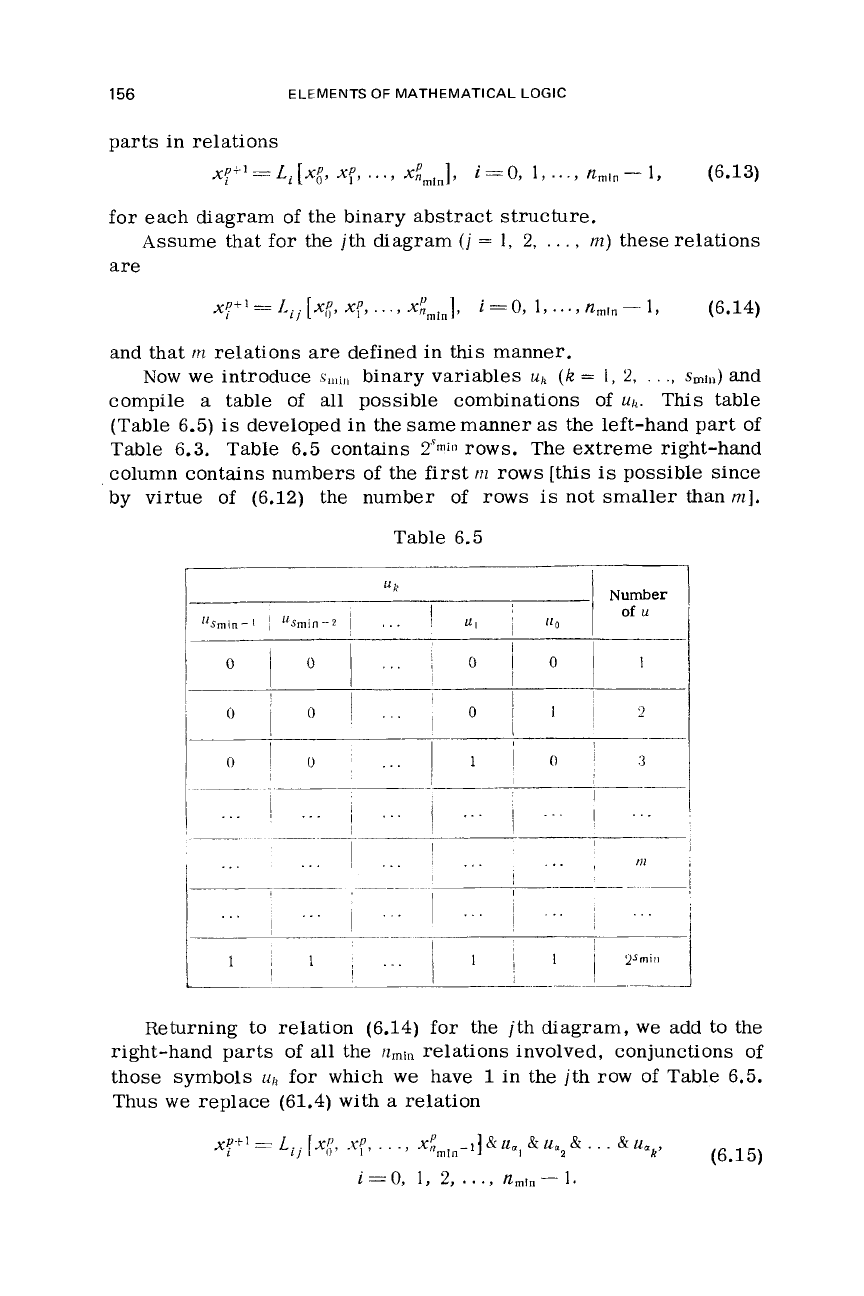
156
ELEMENTS
OF
MATHEMATICAL LOGIC
parts in relations
x!+'
=
Li
[x:,
~f,
.
.
.,
x$~~,],
i=O,
1,
. .
.
,
nmIn
-
1,
(6.13)
for each diagram of the binary abstract structure.
are
Assume that for the jth diagram
(j
=
1,
2, .
.
.
,
rn)
these relations
and that
rri
relations
are
defined in
this
manner.
Now
we
introduce
slllill
binary variables
ujt
(k
=
1,
2,
.
.
.,
smln)
and
compile a table
of
all possible combinations of
uk.
This table
(Table 6.5)
is
developed in the same manner
as
the left-hand part of
Table
6.3.
Table 6.5 contains
2'mill
rows. The extreme right-hand
column contains numbers
of
the first
m
rows
[this
is
possible since
by virtue of (6.12) the number
of
rows
is
not smaller than
m].
Table 6.5
Returning to relation (6.14) for the jth diagram,
we
add to the
right-hand parts of all the
izlnin
relations involved, conjunctions
of
those symbols
uk
for which
we
have
1
in the jth row
of
Table 6.5.
Thus
we
replace (61.4) with a relation
(6.15)
,y+'
=
Li,
[Xt,
X'f.
. . .
,
XRml"-l]
8:
urn,
8r
ua2
.
. .
c3
Uak,
i=o,
1,
2,
...)
nmln-
I.
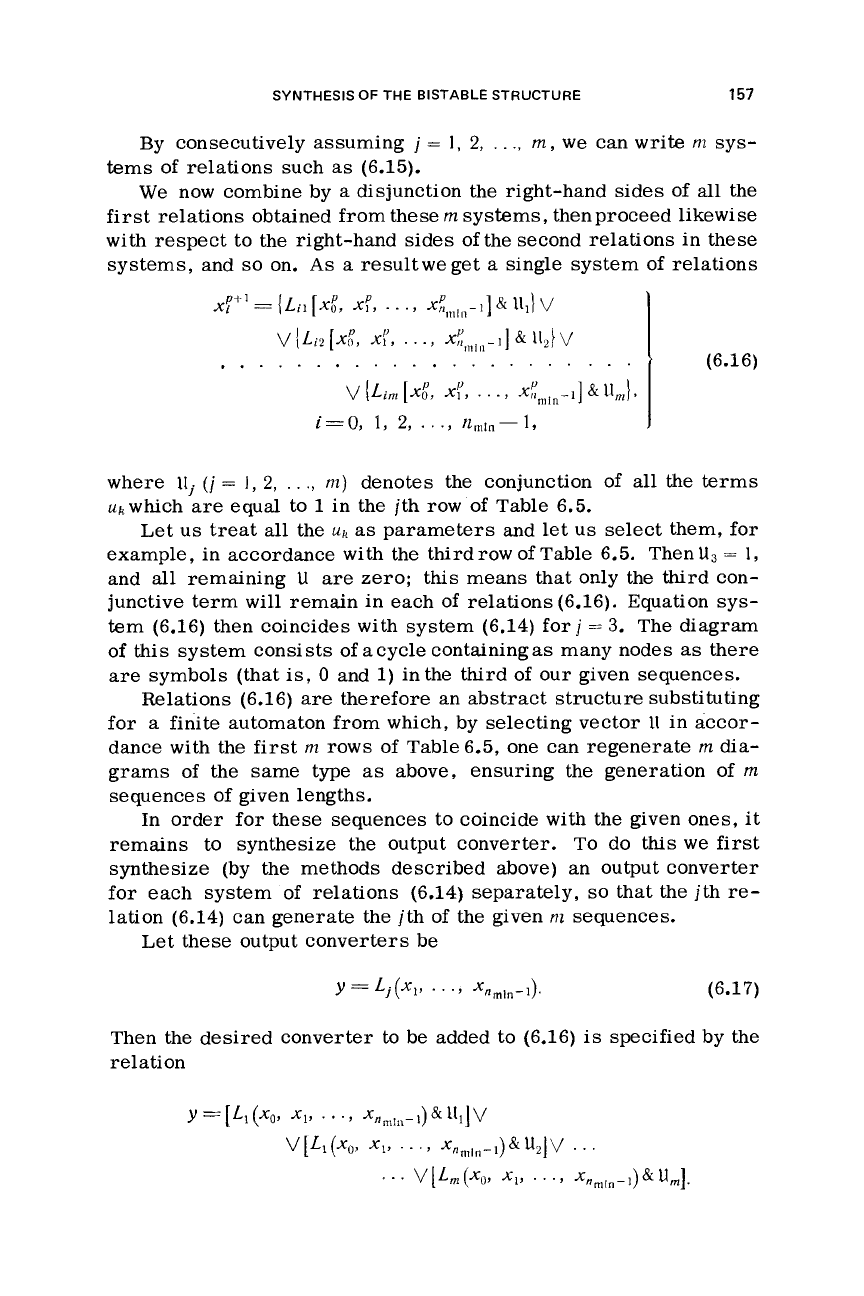
SYNTHESIS
OF
THE BISTABLE STRUCTURE
157
XP'
=
{Lil
[Xi,
XP,
. . .
,
X~,l,l,l-l]
&
Ill\
v
v
(Liz
xY,
.
.
.
j
x:,~,,,,-
11
&
I[,/
v
......................
v
(Lim
[X&
XY,
. .
.,
X:",,n-l]
&Urn).
i=O,
1,
2,
.
.
.,
iz,,ln-
1,
(6.16)
where
llj
(j
=
1,
2,
. .
.,
rn)
denotes the conjunction of
all
the terms
ukwhich
are
equal to
1
in the jth row of Table 6.5.
Let
us
treat
all
the
uk
as
parameters and let
us
select them, for
example, in accordance with the thirdrowof Table 6.5. ThenU3
=
1,
and
all
remaining
U
are
zero;
this
means that only the third con-
junctive term
will
remain in each of relations (6.16). Equation sys-
tem (6.16) then coincides with system (6.14) for
j
=
3.
The diagram
of this system consists of acycle containing
as
many nodes
as
there
are
symbols (that is,
0
and
1)
inthe third
of
our given sequences.
Relations (6.16)
are
therefore an abstract structure substituting
for
a
finite automaton from which, by selecting vector
11
in accor-
dance with
the
first
m
rows of Table 6.5, one can regenerate
rn
dia-
grams of the same type
as
above, ensuring the generation of
rn
sequences of given lengths.
In order for these sequences to coincide with the given ones, it
remains to synthesize the output converter. To do
this
we
first
synthesize (by the methods described above) an output converter
for
each system of relations (6.14) separately,
so
that the jth
re-
lation (6.14) can generate the jth of the given
nz
sequences.
Let these output converters be
Then the desired converter to be added to (6.16)
is
specified by the
relati
on
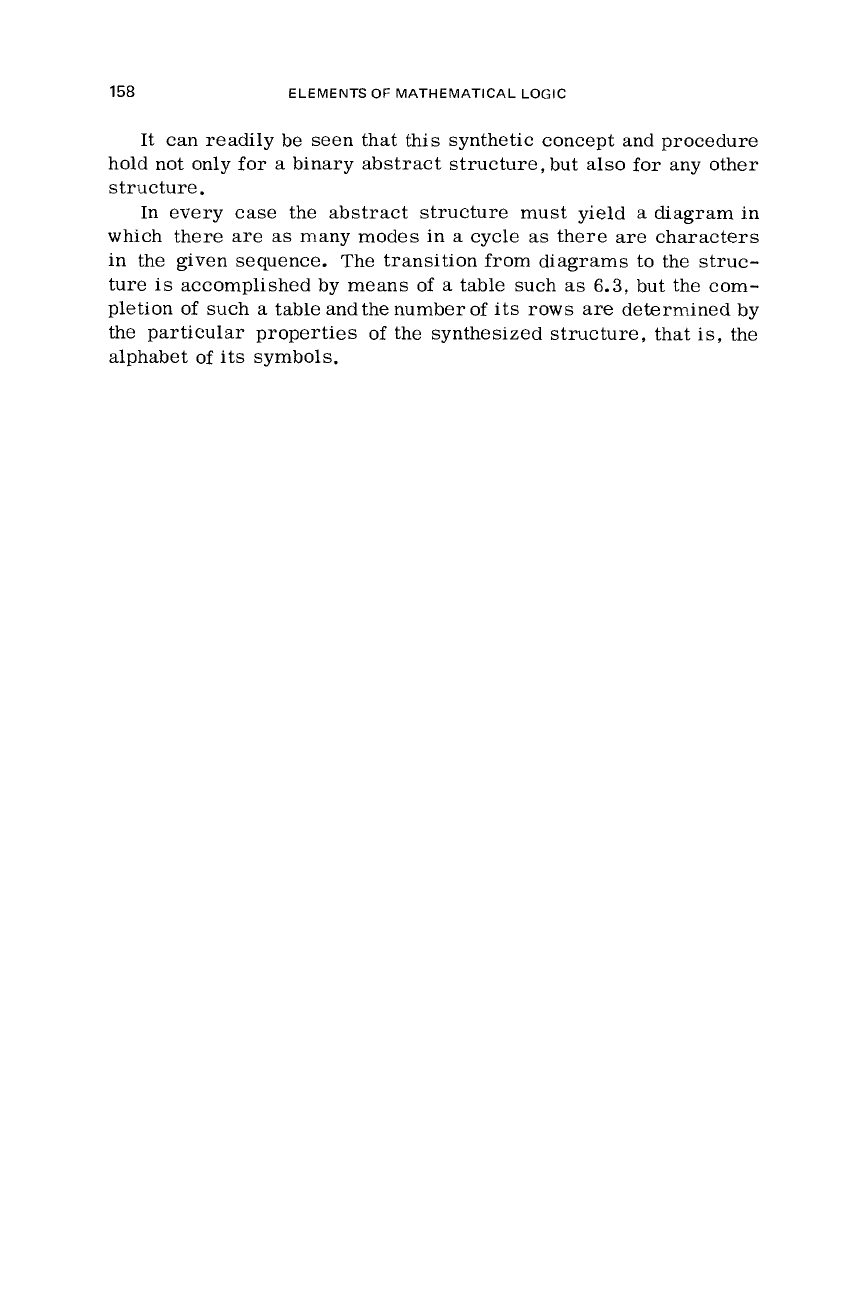
158
ELEMENTS
OF
MATHEMATICAL LOGIC
It can readily be seen that this synthetic concept and procedure
hold not only
for
a
binary abstract structure, but also
for
any other
structure.
In every case the abstract structure must yield
a
diagram in
which
there
are
as
many modes in a cycle
as
there
are
characters
in the given sequence. The transition from diagrams to the struc-
ture
is
accomplished by means
of
a
table such
as
6.3,
but the com-
pletion
of
such
a table
and
the
number
of
its
rows
are
determined
by
the particular properties
of
the synthesized structure, that
is,
the
alphabet
of
its symbols.
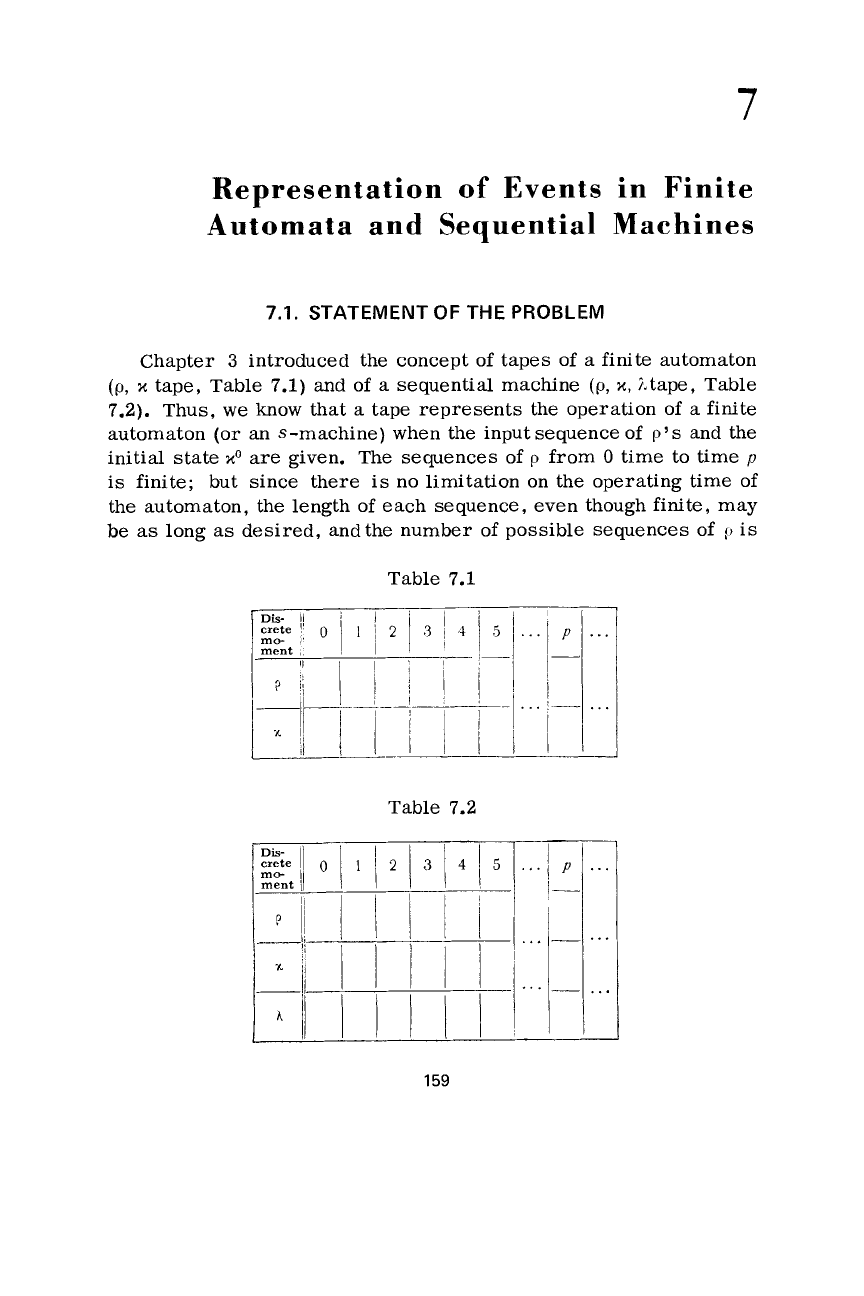
Representation
of
Events in Finite
Automata and Sequential Machines
7.1.
STATEMENT
OF
THE PROBLEM
Chapter
3
introduced
the
concept of tapes
of
a
finite automaton
(p,
~t
tape, Table
7.1)
and
of
a
sequential machine
(p,
x,
>,tape, Table
7.2).
Thus,
we
know that
a
tape represents the operation of a finite
automaton
(or
an s-machine) when
the
input sequence
of
p's
and
the
initial state
xo
are
given. The sequences
of
p
from
0
time to time
p
is
finite; but since there
is
no limitation on the operating time of
the automaton,
the
length
of
each sequence, even though finite, may
be
as
long
as
desired, and the number
of
possible sequences
of
$J
is
Table
7.1
lp
!
I
...
-
Table
7.2
159
-
...
...
-
-
...
...
...
-
